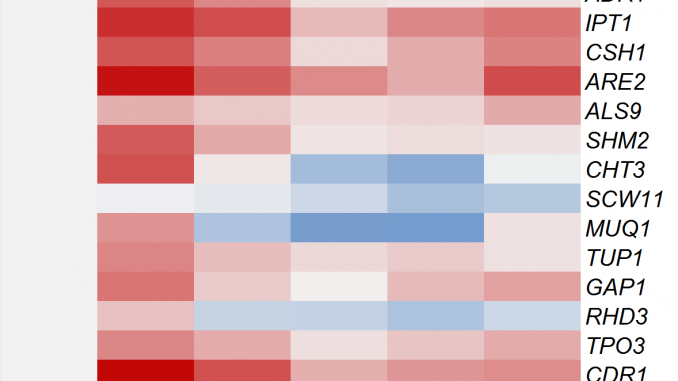
More than 70% of women will experience candida infections once or more in their lifetime. About 5% to 10% of patients may experience recurrent vulvovaginal candidiasis (RVVC). Candida albicans is the main pathogen of candidiasis. It is a unicellular eukaryote with two major morphological forms during infection: yeast and hypha. The morphological form of pseudohyphae only occurs when it is gemmating. Usually, the yeast form exists in oral mucosa, gastrointestinal tract, anus, skin and vagina in healthy individuals, as a commensal organism without pathogenicity. When the individuals are in pathological condition such as suffering from cancer, diabetes and hematologic diseases or local and systemic hypoimmunity, the fungus behaves as a powerful pathogen to cause a disease. Previous studies have shown that the yeast-to-hypha transformation of C. albicans was the critical step of infection, but the pathogenic mechanism had not yet been clearly elucidated.
The genomic sequence of C. albicans has been completely annotated, it is helpful for us to study the pathogenic mechanism of C. albicans at the gene level. The vagina is the most common infection site of this microorganism, however, no studies have ever simulated the infection of C. albicans in female genital tract, thus, we still don’t clearly understand the pathogenesis of candidiasis in this site. In order to explore the pathogenic mechanism of infection, we co-cultured HeLa cells (The Henrietta Lacks cervical cancer cell line) with C. albicans to simulate the infection of genital tract epithelial cells. Then we used a combination of microscopic observation, gene chips, and a series of biological and bioinformatics analyses to study the pathogenic process and the relevant C. albicans genes. We found that in the course of infection, significant morphological changes of fungus happened, and the HeLa cells were gradually destroyed. We screened a number of genes that may play an important role in the pathogenesis of infection. However, this study was conducted in vitro, and the expression of C. albicans genes in an infected host may be different due to immune response to infection, and needs further in vivo investigations. In the present studies, some gene products that may be important to the ability of this fungus to invade the organism have not received sufficient attention, hence, additional studies need to be performed to unravel the pathogenic mechanism of candidiasis and to find better ways to treat it.
超过70%的妇女一生会有一到两次念珠菌感染,而大约5%~10%的患者可迁延为复发性外阴阴道假丝酵母菌病(RVVC)。白色念珠菌是假丝酵母菌的主要致病菌,它在感染的时候主要以酵母及菌丝的形态存在,而假菌丝形态主要在出芽生殖的时候存在。一般来说,念珠菌平时以共生的酵母形态存在于健康人群的口腔上皮,胃肠道,肛门,皮肤和阴道中,不致病。当个体因为罹患癌症,糖尿病,血液病,局部或全身的免疫低下时,该真菌则可致病。以前的研究表明酵母相向菌丝相转变是白色念珠菌致病的重要步骤,但其致病机制至今尚未完全阐明。
白色念珠菌的基因测序已完毕,这为我们在基因层面上来研究它的致病机制提供了便利。阴道是白色念珠菌最常见的感染部位,但是目前尚没有研究来模拟阴道局部的白色念珠菌感染,我们尚不清楚它在这个部位的感染机制。为了解释白色念珠菌在该局部的致病机制,我们将白色念珠菌与Hela细胞共同培养来模拟念珠菌感染阴道上皮的过程,然后通过显微镜检,基因芯片,生物和生物信息学的一系列分析来研究它的致病过程和相关的基因改变。我们发现在感染过程中,白色念珠菌具有显著的形态学改变,HeLa细胞则逐渐被破坏。同时我们筛查出多个可能在白色念珠菌致病过程中起重要作用的基因。但是,这个研究过程是在体外实施的,在宿主体内因为有免疫系统的参与,白色念珠菌基因的改变可能不一样,这需要我们进一步的在体实来研究验。在目前的研究中,一些可能和白色念珠菌致病密切相关的基因产物没有引起大家的足够重视,因此,接下来需要更多的相关研究,这些可能会帮助我们阐明念珠菌病的致病机制,并找到更好的治疗方法。
Reference
Yi Bing Lan, Fan Qu, Juan-Qing Li, Lin-Juan Ma, Jie Yan, Jian-Hong Zhou. Time course of global gene expression alterations in Candida albicans during infection of HeLa cells. Bosn J Basic Med Sci 2017; [ahead of print]. DOI: http://dx.doi.org/10.17305/bjbms.2017.1667 PMID: 28397609
Leave a Reply